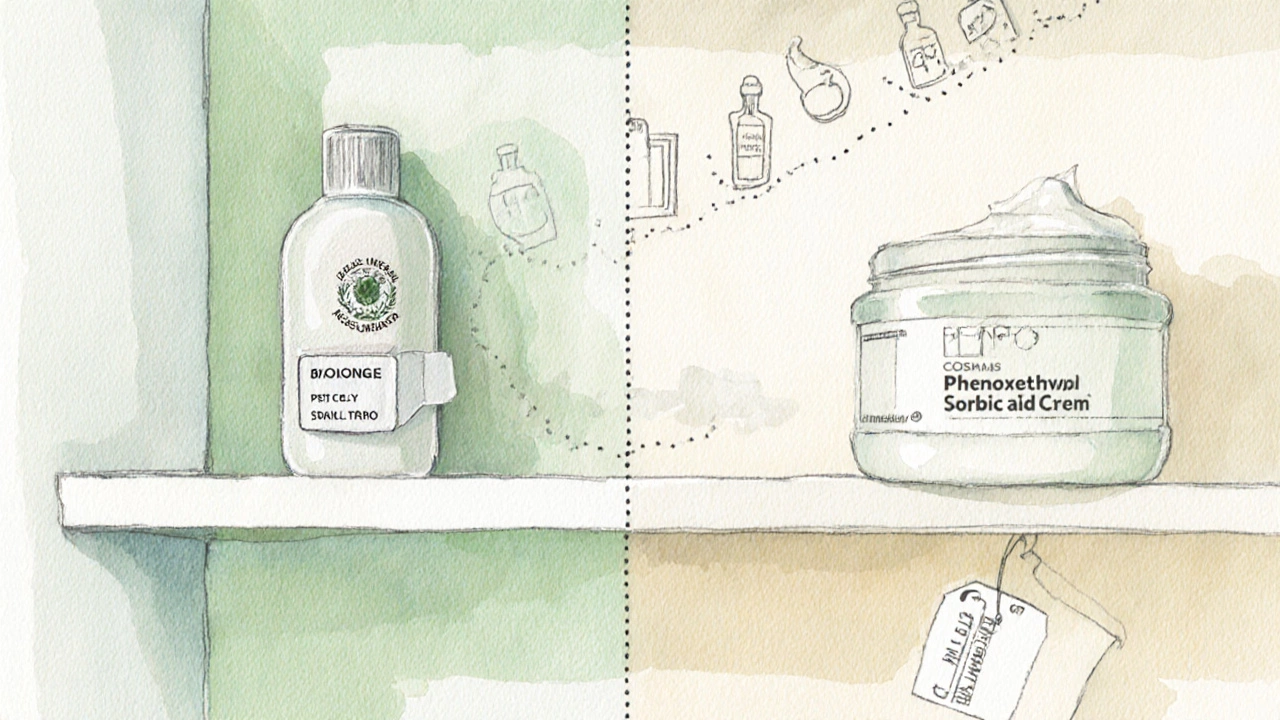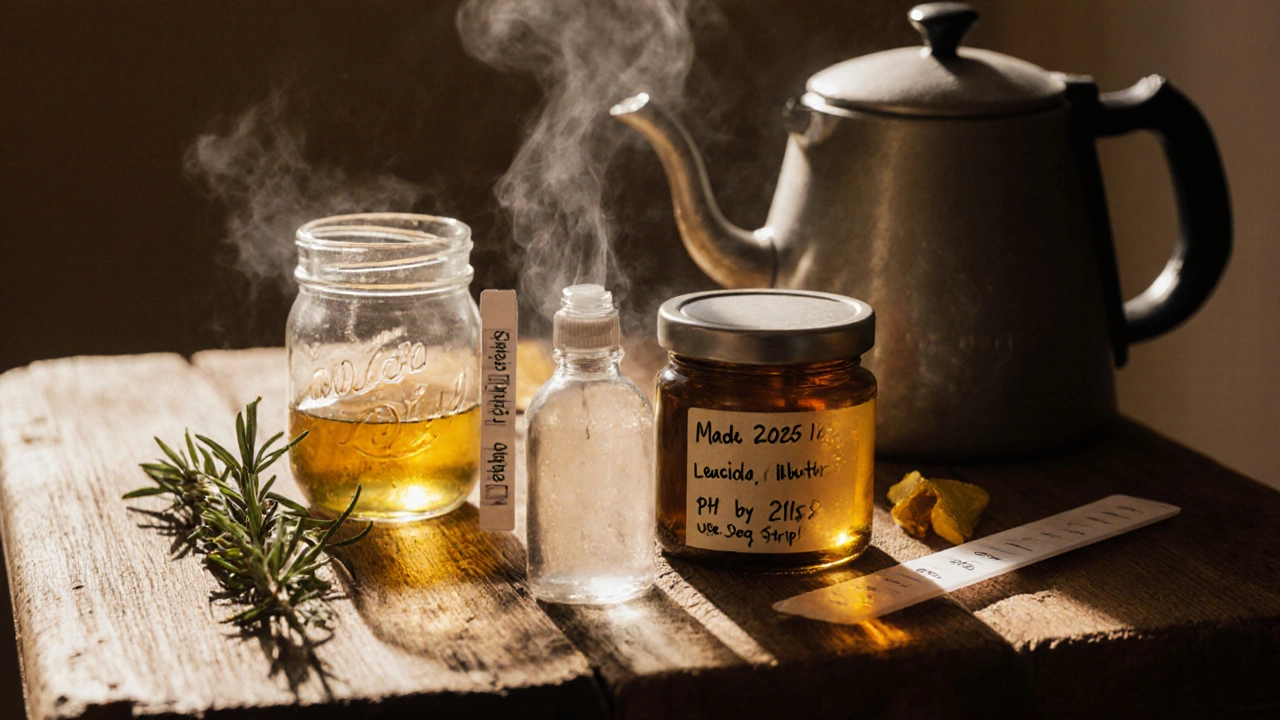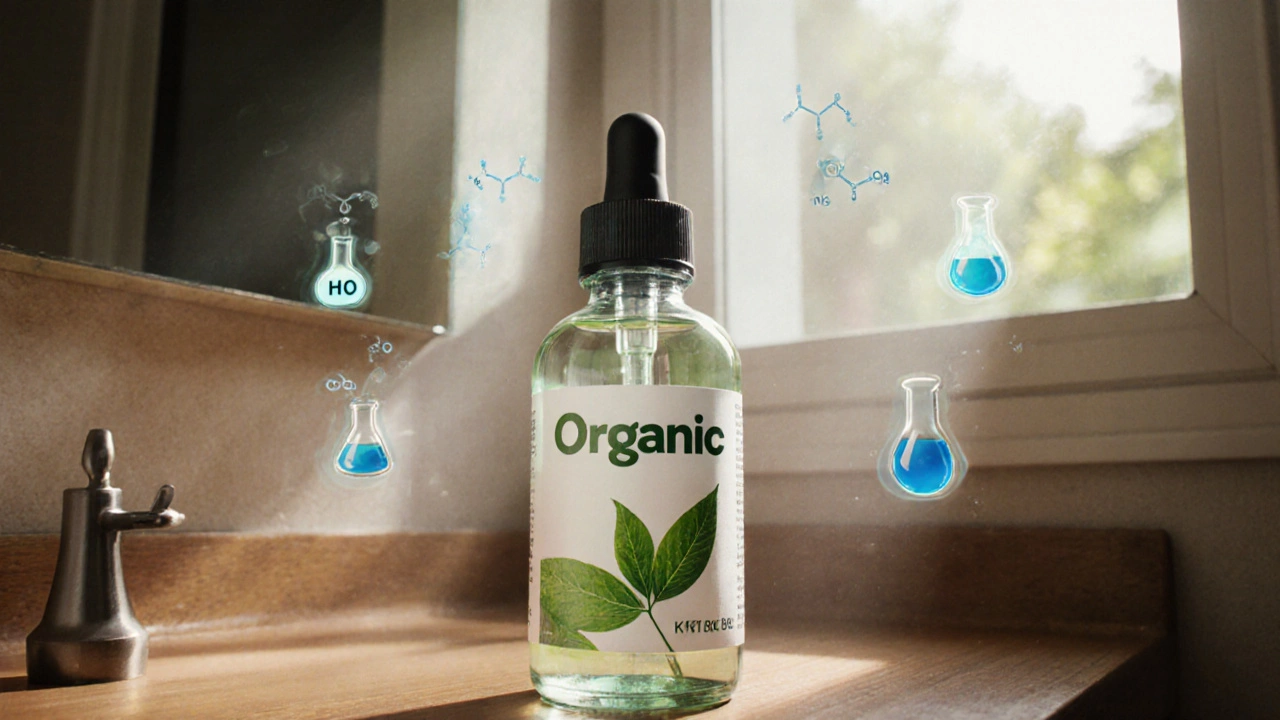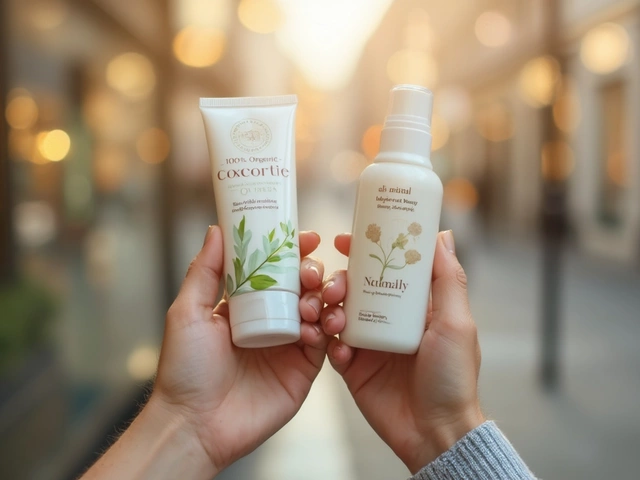Organic Skincare Ingredient Checker
Check Ingredient Permissibility
Enter an ingredient name to see if it's allowed in USDA Organic, EU Organic, or COSMOS-certified skincare products.
Note: The presence of an ingredient doesn't guarantee safety for all skin types. Natural ingredients can still cause reactions.
When you glance at a bottle that says “organic,” you probably picture a product made entirely of nature‑derived goodies, with zero chemicals whatsoever. That mental picture feels good, but the reality is messier. Let’s untangle what “chemical‑free” actually means, what the organic label allows, and how you can spot the truly clean stuff in the crowded skincare aisle.
What does “chemical‑free” even mean?
First off, everything is a chemical. Water is H₂O, sunlight is a mix of photons, and even the air you breathe is nitrogen, oxygen, and a handful of trace gases. So when marketers shout “chemical‑free,” they’re really saying “no synthetic chemicals that you might find in a lab.” That’s a subtle but important distinction.
In a practical sense, “chemical‑free” is a marketing shorthand for “no synthetic additives that are flagged as harmful or unnecessary.” It doesn’t guarantee the absence of naturally occurring substances that could irritate your skin - think essential oil allergens or high‑concentration fruit acids.
How does an organic certification work?
Organic products are defined by a set of standards that govern how raw materials are grown, processed, and labeled.<\/span> In the United States, the USDA’s National Organic Program (NOP) is the go‑to rulebook. To earn the USDA Organic seal, at least 95% of the ingredients by weight must be organically produced, and the remaining 5% must be on the approved National List of allowed substances.
Europe follows a similar but stricter framework under the EU Organic Regulation. Both systems require an independent audit, a certified organic farm, and a documented supply chain. The key takeaway? “Organic” means the product meets specific criteria - not that it is magically devoid of all chemicals.
Common chemicals still allowed in organic skincare
Even with strict rules, some synthetic ingredients slip through the cracks because they’re on the approved list. Here are the most common culprits you’ll still see on an organic label:
- Synthetic chemicals like sodium benzoate, a preservative permitted by the USDA Organic list.<\/span>
- Phenoxyethanol - a low‑toxicity preservative tolerated in the EU Organic standard.
- Citric acid - often derived synthetically but also allowed as a pH regulator.
- Potassium sorbate - another preservative on the USDA National List.
- Some fragrance compounds derived from natural sources but chemically altered (e.g., linalool oxides).
These ingredients aren’t banned because they’re considered safe at the low concentrations used, but they do mean the product isn’t 100% free of synthetic chemicals.

Natural ingredients aren’t always harmless
Natural ingredients can still cause trouble for sensitive skin.<\/span> Rosemary extract, for example, is a potent antioxidant but can be irritating in high doses. Essential oils like lavender or tea tree are great for fragrance and antimicrobial properties, yet they’re common allergens.
The organic label doesn’t certify that a product is hypoallergenic; it merely guarantees the source of the ingredients. So if you have a known sensitivity, always check the full INCI list, not just the front‑pack claim.
Reading the label: certifications that matter
Beyond the USDA and EU seals, other third‑party standards help you gauge how “clean” a product is:
- COSMOS Standard - a European certification that blends organic, natural, and cruelty‑free criteria.<\/span>
- Ecocert - a French organic certification that also audits processing methods.
- NSF/ANSI 305 - an American standard for personal care products containing at least 95% organic ingredients.
When you see any of these logos, you can be confident the product met a verified set of rules. However, each certification has its own list of permissible additives, so they’re not interchangeable.
Comparison: What’s allowed in USDA‑Organic vs. EU‑Organic skincare?
| Ingredient Category | USDA‑Organic (Allowed) | EU‑Organic (Allowed) | Commonly Prohibited |
|---|---|---|---|
| Preservatives | Sodium benzoate, Potassium sorbate | Phenoxyethanol, Sorbic acid | Parabens, Formaldehyde releasers |
| Fragrances | Natural essential oils (if not chemically modified) | Natural oils + limited synthetic aroma compounds | Synthetic fragrance mixes, Phthalates |
| UV Filters | None (organic sunscreen not yet certified) | Zinc oxide, Titanium dioxide (non‑nano) | Octinoxate, Oxybenzone |
| Colorants | Mineral pigments, Plant extracts | Same as USDA, plus certain approved synthetic dyes | Artificial dyes (e.g., FD&C colors) |
This table shows that both regimes ban the heavy hitters like parabens, but they make room for a handful of low‑risk synthetics. If you’re hunting for the purest formulation, look for products that voluntarily avoid even the permitted additives.

DIY organic skincare: pros, cons, and safety tips
Making your own organic face oil or mask feels empowering, and you have total control over every ingredient. However, DIY formulas often lack the stability that commercial preservatives provide. That means a homemade cream can turn rancid or grow mold in a week.
Here’s a quick safety checklist for DIY lovers:
- Use fresh, high‑quality organic oils and butters - keep them refrigerated.
- Measure pH with strips; most skin‑friendly products sit between 4.5 and 5.5.
- Add a natural preservative like Leucidal Liquid (a radish‑based antimicrobial)<\/span> if you plan to store more than a few days.
- Label with date and batch number; discard after 30 days.
DIY can be a great way to avoid those “allowed” synthetics, but it requires discipline and a bit of chemistry knowledge.
Key takeaways
- “Chemical‑free” is a marketing shortcut; everything is a chemical.
- Organic certifications (USDA, EU, COSMOS) set strict ingredient limits but still permit a short list of low‑risk synthetics.
- Natural ingredients can still cause irritation; always read the full ingredient list.
- Look for additional certifications and read the small‑print to see what additives are truly excluded.
- DIY offers control but needs proper preservation to stay safe.
Frequently Asked Questions
Are all organic skincare products preservative‑free?
No. Both the USDA and EU allow a handful of preservatives like sodium benzoate or phenoxyethanol. These are considered low‑risk and keep the product stable.
Can a product be labeled “organic” if it contains synthetic fragrance?
Yes, if the fragrance is on the approved list. The EU, for instance, lets certain synthetic aroma compounds in organic cosmetics, provided they meet safety thresholds.
What’s the difference between USDA‑Organic and COSMOS certification?
USDA‑Organic focuses on agricultural production and caps synthetic ingredients at 5%. COSMOS combines organic, natural, and cruelty‑free criteria, often requiring a higher percentage of natural content and stricter limits on processing aids.
Should I avoid all products that list ‘natural fragrance’?
Not necessarily. “Natural fragrance” usually means essential oils or botanical extracts, which can be allergenic. If you have sensitive skin, check the specific oils listed in the INCI.
Is DIY skincare always safer than store‑bought organic products?
DIY gives you full ingredient control, but without proper preservation you risk contamination. Commercial organic products, even with allowed synthetics, undergo stability testing that home mixes often lack.


